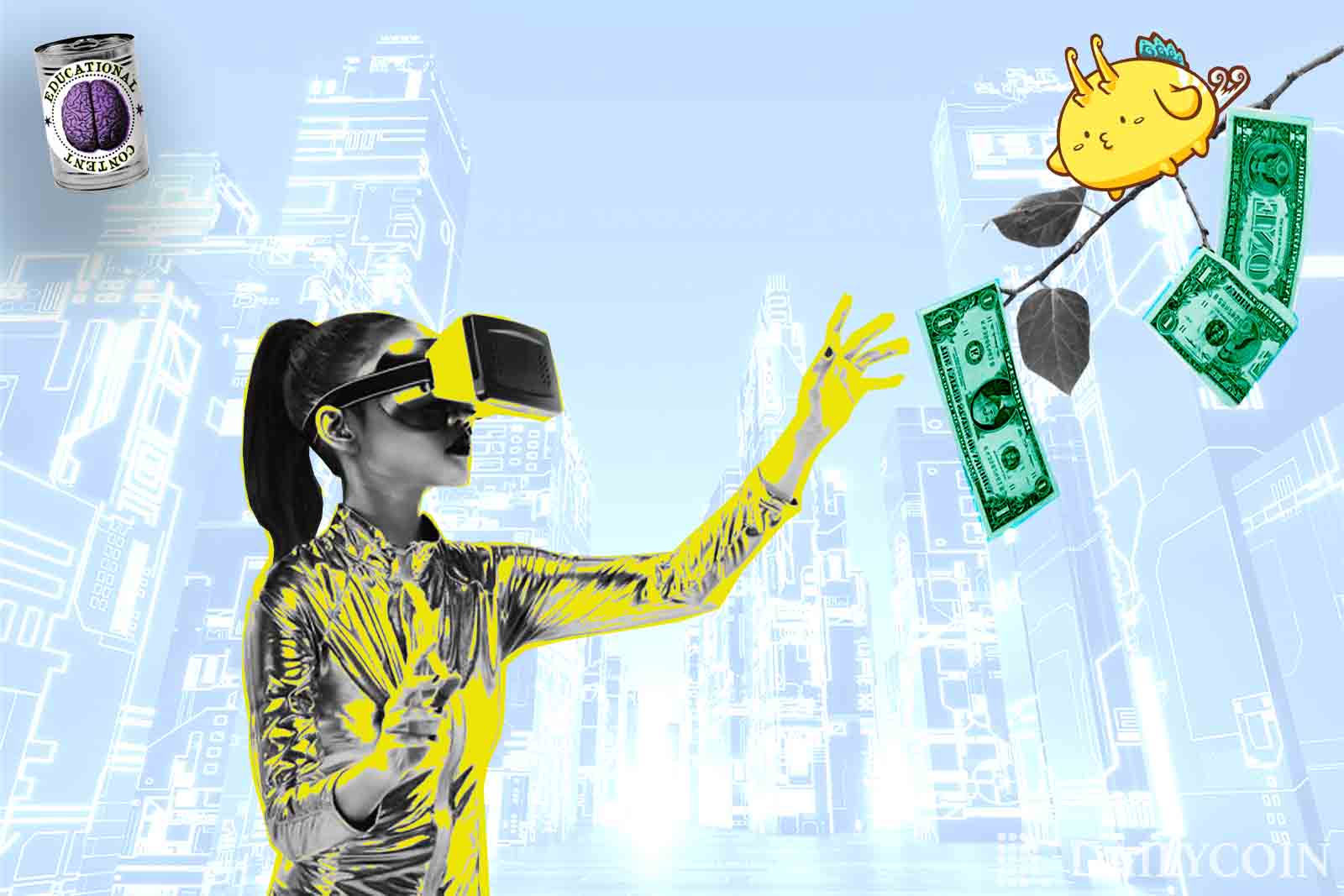
With the rise of cryptocurrency and NFTs, play-to-earn gaming has become increasingly popular. Previously, people paid to play video games, but now, gamers have the opportunity to enjoy the most thrilling video games while making a lot of money by doing so.
Of all the ways blockchain technology has affected the world, blockchain gaming is potentially the most lucrative, giving birth to GameFi and the powerful play-to-earn gaming economy. But before we dive deeper into the topic, let’s quickly take a look at the history of GameFi.
The History of GameFi
The term “GameFi”, which is a short for gaming finance, can be traced back to when the founder of MixMarvel, a blockchain game publishing platform, delivered a speech in China at the Wuzhen World Blockchain Conference in November, 2019.
Sponsored
While Mary Ma’s speech was the first time the term GameFi was used, marking the beginning of the sensationalism surrounding the technology, the fundamental concept of GameFi existed long before the speech (titled “GameFi- Path of technology-driven innovation in the gaming industry” for anyone interested in checking it out).
In fact, the concept behind GameFi is almost as old as Bitcoin itself, dating back to 2013, when gaming titles like ‘Minecraft’ and ‘Bombermine’ were experimenting with BTC integration. More specifically, by leveraging peer-to-peer services in-game, the titles enabled gamers to monetize their gaming experience, using BTC as a medium of exchange.
Years down the line, we have seen more precise exploration of GameFi in projects like ‘CryptoKitties‘, built on the Ethereum network.
Sponsored
CryptoKitties features in-game assets represented by non-fungible tokens (NFTs). Players acquire these NFTs in order to breed unique cats, which can then be traded on a dedicated marketplace.
Interestingly, while CryptoKitties didn’t experience much success due to a variety of factors, including a clogged network, limitations on the developers’ ability to implement complex game functions, a poor gaming experience, and a lack of competitive market in the blockchain industry, it did pave the way for a wave of new projects that make up the GameFi ecosystem as we know it today.
So, What Is GameFi?
For those unfamiliar with gaming, let us put it this way: GameFi is to the legacy gaming industry, what DeFi is to traditional finance. Essentially, GameFi aims to revolutionalize the traditional gaming infrastructure by combining and integrating blockchain technology and decentralized finance.
Unlike in legacy gaming, GameFi enables players to monetize their gaming experience in two steps – firstly, through the tokenization of in-game assets, and secondly, by leveraging an in-game play-to-earn (P2E) economy.
For instance, in a typical video game, wins are rewarded with some form of ranking points, credits, ratings, stars, and in-game currency—all of which act as mental stimulation, providing a sense of victory. But the key thing is that you can’t take these rewards outside of the game, nor use them for any valuable form of exchange.
With GameFi, the narrative changes. Because they are based on blockchain, GameFi protocols, or gaming titles, provide players with rewards that can be easily monetized in the real world. These rewards often come in the form of cryptocurrencies and NFTs, which, when earned by players, can be exchanged for genuine legal tender.
Already, many people have gotten rich through GameFi, and they take pride in making money while also having fun. Parents who used to admonish their children for playing video games are beginning to support them due to the financial benefits.
How Does GameFi work?
GameFi, like the majority of blockchain-based projects, subsists through distributed ledger technology, which is another term for blockchain technology. However, each GameFi project has its own unique mechanics in terms of both the technical elements, and the type of reward system being implemented.
Regardless, GameFi generally uses blockchain as the underlying infrastructure to provide players with verified asset ownership, as well as to establish a decentralized marketplace on which traders can exchange in-game, tokenized items (NFTs), both in and outside the game.
For instance, in each GameFi protocol, in-game items such as weapons, skins, gold, pets, artifacts, etc, are tokenized and represented as NFTs.
As a result, when players compete and acquire any of these in-game items, they automatically claim full ownership of them, and have the ability to trade them, whether through the protocol’s dedicated marketplace, or outside the game’s world.
In some situations, in-game assets are not NFTs, but they can be converted into NFTs using third-party applications like Hoard Exchange, and subsequently sold for profit. Hoard Exchange is known for bridging the gap between NFT technology and the traditional gaming industry. You can learn more about the project via the link below.
Hoard Exchange to Bridge the Gap Between NFTs and Regular Game Industry
That said, if you are not in a hurry to make financial gains, players can keep accumulating wins and in-game assets by refusing to sell. In fact, it can even be benefical to do so, as most games have systems in place that allow in-game assets to be exchanged for better tools, more powerful items, and other boosts, making it easier to win more.
The financialization of gaming protocols in order to incentivize players gave rise to the ‘play-to-earn’ gaming model. Nowadays, it is almost essential for every genuine GameFi protocol to have an incentive model or reward system in place.
Similarly, DeFi features are also incorporated into most GameFi projects as a secondary reward system. This allows the integration of known concepts from the DeFi space such as yield farming, liquidity mining, and staking, thereby providing a passive means of generating revenue while playing the game.
Some prominent blockchain gaming titles to have infused the aforementioned DeFi concepts include the likes of ‘Axie Infinity‘, ‘Decentraland‘, ‘Aavegotchi‘, ‘DeFi Kingdoms‘, ‘Nine Chronicles‘, and many more.
Understanding the Play-to-Earn Gaming Economy
Since players can monetize the winnings they earn from blockchain games, it means that, apart from getting paid to have fun, players are also paid for their time. So the in-game economy of a particular video game will determine how much time a player spends playing it.
This is because the game loop is designed to keep the players engaged and happy, while also supporting its core plot and natural dynamics.
From the perspective of economics, a play-to-earn economy must have the following five characteristics in order to keep players engaged, prolong the time spent in-game, and increase the amount of money players can make from the game.
1. Priority on Playerbase Over Governance
If a game doesn’t have a polished design and a solid number of players playing it, then there is no need for a governance system.
In this context, governance refers to governance tokens—cryptocurrencies that give the community around a project the right to vote or make major decisions for the future of the blockchain project, in this case, the game’s direction.
A loyal playerbase has to be realized before any significant governance can take effect, otherwise it would be wasted.
2. Take Multiple Economic Agents into Consideration
When thinking about traditional gaming, game developers and players are typically the two major driving factors of a game’s success. In fact, the idea of other influential agents is often overlooked.
But there are a few others that must also be factored in when it comes to play-to-earn games, those being investors, builders, and collectors that drive the in-game economy.
The investors are the financial backers of the game. While many of them may have purchased speculatively, their money goes a long way to making the game’s development a success.
Collectors may not actively play the game, but they are involved in the NFT side of things, generating the demand that makes the P2E system run. Conversely, builders might generate that supply of value in and outside of the game.
3. A Game That Can Stand Tall Even Without the “Earn” Aspect
While blockchain games are indeed play-to-earn, and draw their playerbases, in part, for the value they can generate, the game has to be built in such a way that its survival does not solely depend on those earnings. Games should always be able to engage players on an entertainment level, and the financial aspect should not take precedence.
If a video game is more about earning than the thrill of the experience and how enjoyable it is, then it will be unsustainable, as the userbase will swiftly dwindle. This is not exclusive to P2E gaming, as even in traditional gaming, games lacking an “end-game” can dramatically lose popularity. This serves as a good indication that one aspect alone is not enough, and a balance must be struck between entertainment and value.
4. Higher Passive Revenue = Lower Player Activity
As stated above, the play-to-earn economy will die if the entire video game is focused on the financial aspect; if the only draw is the money, then there is no engagement.
Similarly, if people can earn money from the game without actively participating in completing tasks such as robbing a bank and obtaining loot, killing a monster and earning points, or racing and winning prizes, then economic activity such as P2P trading will decline.
GameFi projects looking to draw players in with passive earnings must include models like renting, which allow people to make money from loaning items such as safe houses or weapons that will actively be used in the game itself by someone else.
5. The Value of Player-Generated NFTs Must Be Protected
If a game designs a gaming economy that revolves around players creating their own NFT content, then sufficient investment must be made into protecting their interests, and the value of the content produced.
How to Get Started with GameFi
Those already familiar with cryptocurrencies and NFT trading will find this extremely easy to do. Of course, being a gamer also gives you an advantage over any newbies looking to start playing for the money.
However, if you don’t fit into any of the aforementioned categories then there is no need to worry. The overall process is easy enough, and the sheer variety of video games on the blockchain are diverse and thrilling enough to keep anyone engaged while earning substantial rewards. The following steps will guide you into getting started on your GameFi journey:
Step One: Creating a New Crypto Wallet
Even if you already have one, it is important to you create a wallet for your GameFi account, as your GameFi experience should be considered a new investment. Be careful though, and as always do your research, as different games might require different wallets for blockchain network connections, so make sure to choose one that’s supported by your chosen game.
Step Two: Connect Your New Wallet to the Game You Want to Play
Visit the game’s official website, then click on the option that reads “connect your wallet”, or something to that effect. This will allow you to earn digital assets, which will be sent to your wallet, allowing you to trade or hold them as you wish
Step Three: Fulfill the Starting Requirements
In GameFi, each game has different starting requirements, but one thing that is consistant across them is that you will need to buy their initial tokens—usually NFTs.
These tokens will serve as your initial investment, which is why it’s important to create a new wallet, and only fund it with money you can afford to lose.
Finally, beware of fake websites! There are many fake GameFi websites out there, which is why we always urge our readers to double-check any links you receive, and only commit to a project once you are certain of its authenticity. Research is paramount.
